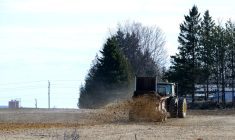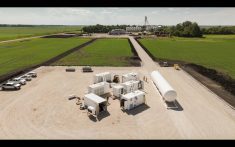Fertilizer, especially nitrogen, uses a lot of energy in its production, particularly natural gas.
That means higher prices as natural gas prices rise, something that’s been kicked into overdrive with the war in Ukraine and Russia’s attempt to blackmail Europe by shutting down its Nord Stream 1 pipeline.
It’s caused many to wonder if there are alternatives, like manure, sewage sludge or compost, that could reduce costs for farmers and consumers.
Read Also

The new spin on farm legacy
Farmers are starting to think differently about the future of their farms in Western Canada. What does this mean for the next generation and farm succession planing?
There is a hitch, however. In recent years, research has shown microplastics have increasingly permeated organic fertilizers and agricultural soils, raising environmental and health concerns. While its impacts are still being gauged, some of the known culprits include littering and abrasive particles from tire wear. Plastic films laid out on certain horticultural crops to prevent temperature fluctuations or water evaporation from soils, known as mulch films, are also suspected to emit them.
Meanwhile, organic fertilizers, compost and sludge soak up household and industry microplastics, accounting for a large part of the problem.
Microplastics pollution is at its worst in agricultural soils of urban regions, where locals typically produce high quantities of sludge and compost that are then applied as organic fertilizers. In Germany, for example, the problem is particularly acute in the country’s industrial west, the Ruhrgebiet, or larger cities such as Hamburg or Hanover.
Science on microplastics is still very much in its infancy. Research so far has suggested they play havoc with soil structure, release contaminants and harm the soil biosphere.
It is even believed microplastics can enter crops and thus the food chain destined for food and human consumption. To date, they have been found in mussels and fish, birds, marine and terrestrial mammals and yes, human beings.
Experiments conducted in laboratories (in vitro) have confirmed some of these hunches. In a 2019 paper, for example, scientists sprinkled microplastics on soil containing ryegrass and earthworms, resulting in the germination of fewer seeds, shorter shoots and greater soil acidity.
As for microplastics’ health impacts, scientists think they present risks at three levels: first through the plastic particles themselves, secondly through the release of persistent organic pollutants absorbed by the plastics, and thirdly, the leaching of additives from the plastics.
The complexity involved in the analysis of micro- plastics’ endless combination of sizes, shapes and chemical signatures means there is little research about their health impacts.
Alarmingly, environmental legislation, regardless of the jurisdiction, typically does not have anything to say on the subject, handing a free pass to contaminate fields.
Changing this will require urgently equipping law- makers with better scientific research. In the mean- time, however, there are practical steps policymakers, farmers and citizens can take to slash dependence on synthetic fertilizers amid the war in Ukraine.
The first is to relocalize food production and make it less dependent on trade, as Europe had already begun to do during the COVID-19 crisis. We can also start to improve the recycling processes of alternative organic fertilizers to substitute synthetic fertilizers in line with the EU’s Nutrient Management Plan from its circular-economy strategy.
Absent any measures, microplastic pollution will continue to accumulate in our ecosystems and possibly even bloodstreams.
Martin Henseler is a research engineer at Equipe d’Economie Le Havre Normandie, Université Le Havre Normandie.















